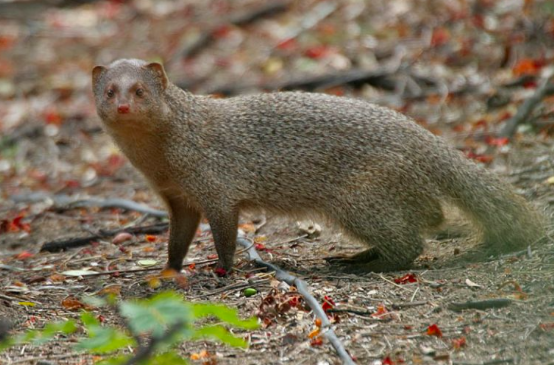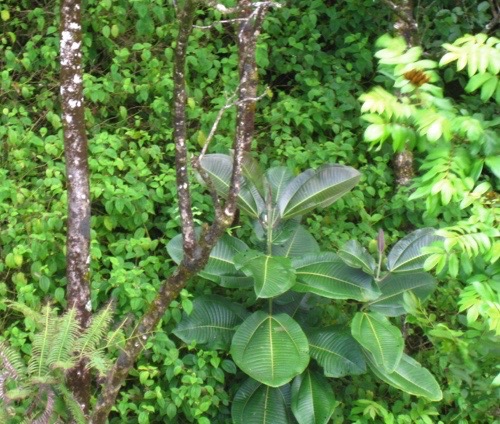In addition to last month’s invasive species conference in Hilo, the Hawai‘i Conservation Conference, held in July in Waikiki, also hosted speakers and featured posters reporting some of the latest developments in invasive species monitoring and control. The following are just a few examples:
Mongooses on Kaua‘i: A False Alarm?

At the Hawai‘i Conservation Conference six years ago, Theresa Menard of The Nature Conservancy of Hawai‘i shared modeling results showing how difficult it would be to eradicate mongooses from Kaua‘i if a population were to become established. The weasel-like creatures are established on all of the main Hawaiian islands except Kaua‘i and Lana‘i.
Mongooses are an invasive species that eat the eggs and hatchlings of ground nesting birds and sea turtles, as well as birds, including the endangered Hawaiian crow (‘alala), petrels (‘ua‘u) and Hawaiian goose (nene), according to a state Department of Land and Natural Resources website.
At the time of Menard’s report, the recent capture of two mongooses, coupled with dozens of sightings, led her and colleagues from the Kaua‘i Invasive Species Committee (KISC) and the National TropicalBotanical Garden to estimate that there were about 54 mongooses on Kaua‘i. Modeling suggested that managers could eradicate mongooses from the island in three to 15 years if they culled nearly 30 mongooses a year. And that was IF no more of the animals made their way to the island.
But since 2012, after setting more than 1,000 tracking tunnels across the island, KISC has found no evidence that the invasive pest has become established. The tunnels, baited with fish paste and fitted with ink pads to record footprints, detected cats, rats, mice, and insects, but no mongooses, according to a poster at the conference.
“[T]he bait attracted a variety of wildlife,sufficient to conclude that if mongooseswere present on Kauai, track evidence would have been detected in the assessment,” the poster by KISC stated.
That’s not to say there aren’t any mongooses on the island. “The premise underlying [the study] assumes one mongoose or a few widely dispersed individuals pose little to no risk of establishing a population,” it stated.
Even so, the organization said it is prepared with sufficient resources and crewthis year should credible sightings reach its “response threshold” of three sightings within a two-week period and within an area with a 0.5km radius.
“[T]his assessment was just one part of an overall management strategy to ensure Kaua‘i remains mongoose-free. It is essential that this mongoose population status assessment, and any management response, is followed by a strengthening of biosecurity procedures to minimize the risk of transporting mongooses to Kaua‘i from elsewhere in Hawai‘i,” the poster stated.
Artificial Intelligence Can Spot Invasives

Police forces across the country are using facial recognition technology to identify criminals. While the practice has generated some controversy, leading some cities to go so far as banning it, researchers in Hawai‘i are experimenting with a similar technique to identify, track and eradicate invasive species faster than ever before.
At the conference, several speakers and posters discussed how drones have helped manage and/or monitor everything from feral ungulates to mitred conures to soil crusts. For example, James Parker of the Big Island Invasive Species Committee said that taking photos and video of forested areas with a drone that records GPS coordinates— as opposed to conducting on-the-ground surveys — has allowed his organization to focus invasive species eradication efforts in vast areas and likely saves his staff more than 2,000 hours a year.
University of Hawai‘i at Hilo associate professor of geography Ryan Perroy has taken things a step further, using drone images to train computers to identify invasive species or plant diseases such as rapid ‘ohi‘a death (ROD).
He recently used a drone to survey ROD-infected trees on Kaua‘i and ended up with thousands and thousands of photos. To manually go through those photos and identify the infected plants takes a lot of time and humans aren’t always reliable. “People get hungry and they have to go to the bathroom. Maybe they’re falling in love and [their mind is elsewhere],” he said.
So he’s tried to get computers to help.
During his conference presentation, Perroy showed a photo from Hawai‘i island of miconia, an invasive plant that has become widespread on the island and has devastated forests in Tahiti. Some of the plant’s large, distinctive purple and green leaves were easy to see; others were obscured by foliage.
Perroy has employed an algorithm called Convolutional Neural Networks to help identify targets much faster than any human. CNNs are “really good at detecting features … whether it’s peoples’ faces or bananas,” he said. And he’s had pretty good success using them to find miconia.
But first he had to train the computer. Aided by one of his children, bribed with chocolate, they went through all of the raw aerial photos and drew boxes around each individual miconia leaf they could find. “Hundreds and hundreds of photos and thousands and thousands of boxes to train the computer,” he said.
He added that the time needed to train the computer depends on how unique the species is. “Coconut trees are pretty easy,” he said.
Once the computer has a good idea of what its target is, it can apply that knowledge to new photos.
With regard to photos taken from the Pahoa area, the computer has been able to see some miconia leaves, Perroy said. “It’s not finding every single one and there have been a few cases of misclassification. But it’s doing pretty well,” even picking up leaves in deep shadow, he said.
“If you’re bleary eyed, you might miss that one. The computer doesn’t get tired,” he added.
He’s now training computers to identify different stages of ROD. Until now, managers have just been looking at the trees that the disease has turned red, which are pretty easy to spot.
“Our current CV [computer vision] classifier can process ~200 images per hour, reducing the processing bottleneck and freeing analysts to examine a much smaller number of curated images. Although overall accuracies of the CV classifier still fall below those of human analysts, the system continues to improve and provides an increasingly powerful supplement to existing image processing workflows,” his abstract states.
Another presenter on remote imaging, Timo Sullivan, seemed to agree that future invasive species management efforts should focus on computer learning.
“We’re running out of eyeballs,” he said.
Dog Trials Show Promise
Hawai‘i resource managers already know how valuable detector dogs can be in preventing the import or spread of invasive species or in aiding eradication efforts. They’ve been used to screen imports, to ferret out rats, and track down feral ungulates. They’ve also been looked at as a possible tool in the fight against predatory snails and little fire ants.
At this year’s conference, researchers reported on studies that suggest dogs may be useful in the battle against the spread of rapid ‘ohi’a death, and to prevent bird carcasses in taro fields from contaminating other birds with avian botulism.
Initially, the extent of ROD was measured by identifying aerially or on the ground the ‘ohi‘a trees that have already started to die and have turned red as a result of their infection. But what if infections could be detected before the trees show the effects? Perhaps they could be saved or treated in some way to prevent further spread of the disease.
According to research led by Kealoha Kinney of the USDA Forest Service, ‘ohi‘a trees in the early stages of a ROD infection smell different from those in later stages. His team of researchers from the U.S. Geological Survey, USDA Agricultural Research Service, and Florida International University, has been able to train dogs to detect those scent differences.
They used what’s known as Controlled Odor Mimic Permeation Systems “to safely permeate volatiles from materials containing [Ceratosystis] lukuohia and C. huliohiato canine training aide materials without exposing it to pathogenic fungal spores,” their abstract states.
They reported that during greenhouse trials conducted in October of last year, one of the trained dogs correctly alerted to non-symptomatic, ROD-infected trees. And at Kalopa State Park in Honoka‘a on Hawai‘i island, the dog detected both symptomatic and pre-symptomatic ‘ohi‘a.
After putting them through more than 200 training runs, Julian Mendel of Florida International University said he has high confidence his dogs could be deployed to detect ROD. However, since following dogs around in dense forest may be difficult, he suggested the dogs could be carried around in backpacks.
Prior to working with dogs to detect ROD, Laurel helped train them to detect the fatal laurel wilt disease, which is also caused by a fungus, before symptoms appear.
One of those team members, Michelle Reynolds of the USGS, has also been researching how dogs might improve detection rates of bird carcasses in taro fields to help prevent avian botulism, a paralytic type of food poisoning.
The birds die after ingesting prey containing a neurotoxin produced by the bacteria Clostridium botulinum. Once they die, their carcasses continue the bacteria’s spread if left in the environment.
Reynolds compared an avian botulism outbreak to a wildfire. Flies are vectors and maggots concentrate the toxin, she said.
“It is the most common cause of death in wild birds worldwide,” she said, noting that ducks are the most vulnerable because they filter feed. “Ducks don’t need to eat the maggot. They could eat a beetle or other insect that ate the maggot,” she said.
“The problem is going to be a bigger problem with climate change,” she added. Early detection and removal of those carcasses can help prevent more birds from dying, but finding them in dense vegetation is challenging, her abstract states.
Last year, she, Kyoto Johnson of County Canine, LLC, Kim Uyehara of the U.S. Fish and Wildlife Service, and the USGS’s Steve Hess tested the abilities of four trained and experienced detector dogs at the taro fields within the Hanalei National Wildlife Refuge on Kaua‘i.
What they found was that humans alone found carcasses the dog teams missed and vice versa. The dogs were a little faster than the humans alone, and found slightly more carcasses, 27 compared to 20.
“The bottom line is dogs improved detection probability, but humans are good at finding ones the dogs couldn’t find,” she said. — Teresa Dawson

Leave a Reply